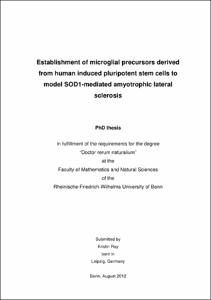Roy, Kristin: Establishment of microglial precursors derived from human induced pluripotent stem cells to model SOD1-mediated amyotrophic lateral sclerosis. - Bonn, 2013. - Dissertation, Rheinische Friedrich-Wilhelms-Universität Bonn.
Online-Ausgabe in bonndoc: https://nbn-resolving.org/urn:nbn:de:hbz:5n-31445
Online-Ausgabe in bonndoc: https://nbn-resolving.org/urn:nbn:de:hbz:5n-31445
@phdthesis{handle:20.500.11811/5640,
urn: https://nbn-resolving.org/urn:nbn:de:hbz:5n-31445,
author = {{Kristin Roy}},
title = {Establishment of microglial precursors derived from human induced pluripotent stem cells to model SOD1-mediated amyotrophic lateral sclerosis},
school = {Rheinische Friedrich-Wilhelms-Universität Bonn},
year = 2013,
month = apr,
note = {Microglia, the resident immune cells of the central nervous system (CNS), are responsible for tissue homeostasis and host defense. After activation, they can also be involved in a wide range of neurodegenerative diseases including amyotrophic lateral sclerosis (ALS). In ~10 % of the hereditary ALS cases, the disease is caused by a mutation in the superoxide dismutase 1 (SOD1) gene. The exact pathophysiological role of mutant SOD1 in human microglia is still unclear.
Microglial precursors were generated from human induced pluripotent stem (iPS) cells to a proliferating cell line to overcome the limitations of primary microglia. The obtained iPS-derived microglial precursor (iPSdM) cells were positively stained for Iba1 and CD68, markers widely expressed on microglia. Moreover, flow cytometry analysis demonstrated the expression of typical microglial markers like CD11b, CD45, CD49d, CD86, CD206 and CX3CR1 whereas the cells were negative for the hematopoietic stem cell marker CD34. Functional analysis revealed the capability of beads and fibrillary amyloid β phagocytosis. Furthermore, iPSdM showed upregulation of tumor necrosis factor α (TNF α ) gene transcription after lipopolysaccharide (LPS) stimulation and chemokine-directed migration towards CX3CL1. Transplantation of iPSdM into the hippocampus of immunodeficient mice showed the capability of these cells to migrate and integrate into the brain parenchyma.
Next, iPSdM were genetically engineered to express distinct human mutant SOD1 to model SOD1-mediated ALS. Mutant SOD1 expressing iPSdM showed no differences in cytokine production or alterations in mitochondrial enzymes in comparison to SOD1 wildtype expressing cells. In contrast, iPSdM expressing SOD1-G37R or SOD1-G93A showed increased induced superoxide production after stimulation with TNF α , LPS or interferon γ , respectively.
Thus, data demonstrate the generation of human microglial precursor cell lines from iPS cells and their application as neuroinflammatory disease model for mutant SOD1- mediated ALS.},
url = {https://hdl.handle.net/20.500.11811/5640}
}
urn: https://nbn-resolving.org/urn:nbn:de:hbz:5n-31445,
author = {{Kristin Roy}},
title = {Establishment of microglial precursors derived from human induced pluripotent stem cells to model SOD1-mediated amyotrophic lateral sclerosis},
school = {Rheinische Friedrich-Wilhelms-Universität Bonn},
year = 2013,
month = apr,
note = {Microglia, the resident immune cells of the central nervous system (CNS), are responsible for tissue homeostasis and host defense. After activation, they can also be involved in a wide range of neurodegenerative diseases including amyotrophic lateral sclerosis (ALS). In ~10 % of the hereditary ALS cases, the disease is caused by a mutation in the superoxide dismutase 1 (SOD1) gene. The exact pathophysiological role of mutant SOD1 in human microglia is still unclear.
Microglial precursors were generated from human induced pluripotent stem (iPS) cells to a proliferating cell line to overcome the limitations of primary microglia. The obtained iPS-derived microglial precursor (iPSdM) cells were positively stained for Iba1 and CD68, markers widely expressed on microglia. Moreover, flow cytometry analysis demonstrated the expression of typical microglial markers like CD11b, CD45, CD49d, CD86, CD206 and CX3CR1 whereas the cells were negative for the hematopoietic stem cell marker CD34. Functional analysis revealed the capability of beads and fibrillary amyloid β phagocytosis. Furthermore, iPSdM showed upregulation of tumor necrosis factor α (TNF α ) gene transcription after lipopolysaccharide (LPS) stimulation and chemokine-directed migration towards CX3CL1. Transplantation of iPSdM into the hippocampus of immunodeficient mice showed the capability of these cells to migrate and integrate into the brain parenchyma.
Next, iPSdM were genetically engineered to express distinct human mutant SOD1 to model SOD1-mediated ALS. Mutant SOD1 expressing iPSdM showed no differences in cytokine production or alterations in mitochondrial enzymes in comparison to SOD1 wildtype expressing cells. In contrast, iPSdM expressing SOD1-G37R or SOD1-G93A showed increased induced superoxide production after stimulation with TNF α , LPS or interferon γ , respectively.
Thus, data demonstrate the generation of human microglial precursor cell lines from iPS cells and their application as neuroinflammatory disease model for mutant SOD1- mediated ALS.},
url = {https://hdl.handle.net/20.500.11811/5640}
}






